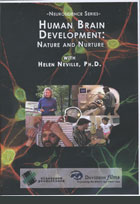
Human Brain Development: Nature and Nurture with Helen Neville, Ph.D. 2007
Distributed by Davidson Films, Inc., 735 Tank Farm Rd, Suite 210, San Luis Obispo, CA 93401; 888-437-4200
Produced by Classroom Productions and Davidson films
Directed by Jim Harrigan
DVD, color, 27 min.
College - Adult
Psychology, Education, Health Sciences, Neurophysiology
Date Entered: 06/27/2007
Reviewed by Lori Widzinski, Health Sciences Library, University at Buffalo, State University of New YorkThis title, part of the Neuroscience Series from Davidson Films, provides a basic foundation of the nature v. nurture concept as it relates to human brain development. Narrator and researcher, Dr. Helen Neville, guides the viewer through several examples of what happens when the brain is developing basic systems such as vision and language. In addition, it illustrates how neuroscience research experiments are conducted.
There is quite a bit of information packed into this 27 minute film. The concept of plasticity is the overarching theme, with introductions to constrained systems (not changing much over the lifespan), modifiable and dependent systems (change based on experience but only at certain times), and highly modifiable (changeable during all parts of the lifespan). These concepts are illustrated through examples like vision development, language and grammar development, and experiments conducted at the Psychology Department Brain Research Lab at the University of Oregon.
Professionally created, this film is a fine complement to the impressive catalog of Davidson Films. It is a welcome addition to the educational psychology and neuropsychology areas, where there are not very many well done introductory programs available. The one problem that stops this reviewer from assigning a higher rating is a lack of balance between the very introductory and the more complicated concepts, creating a challenge for assigning a proper audience level. Nonetheless, it is recommended for senior high through early college library collections.